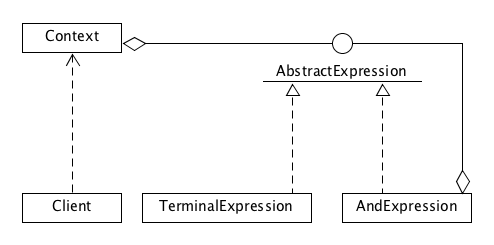
解释器模式(Interpreter)定义:给分析对象定义一个语言,并定义该语言的文法表示,再设计一个解析器来解释语言中的句子。也就是说,用编译语言的方式来分析应用中的实例。这种模式实现了文法表达式处理的接口,该接口解释一个特定的上下文。
解释器模式的优点有:
1、扩展性好。由于在解释器模式中使用类来表示语言的文法规则,因此可以通过继承等机制来改变或扩展文法。
2、容易实现。在语法树中的每个表达式节点类都是相似的,所以实现其文法较为容易。
环境类:
1 public class Context { 2 private String[] citys = { "韶关", "广州" }; 3 private String[] persons = { "老人", "妇女", "儿童" }; 4 private AbstractExpression cityPerson; 5 6 public Context() { 7 AbstractExpression city = new TerminalExpression(citys); 8 AbstractExpression person = new TerminalExpression(persons); 9 cityPerson = new AndExpression(city, person); 10 } 11 12 public void freeRide(String info) { 13 Boolean ok = cityPerson.interpret(info); 14 if (ok) 15 System.out.println("您是" + info + ",您本次乘车免费!"); 16 else 17 System.out.println(info + ",您不是免费人员,本次乘车扣费2元!"); 18 } 19 }
表达式类:
1 public interface AbstractExpression { 2 public Boolean interpret(String info); // 解释方法 3 } 4 5 public class TerminalExpression implements AbstractExpression { 6 private Set<String> set = new HashSet<String>(); 7 8 public TerminalExpression(String[] data) { 9 for (int i = 0; i < data.length; i++) 10 set.add(data[i]); 11 } 12 13 public Boolean interpret(String info) { 14 if (set.contains(info)) { 15 return true; 16 } 17 return false; 18 } 19 } 20 21 public class AndExpression implements AbstractExpression { 22 private AbstractExpression city = null; 23 private AbstractExpression person = null; 24 25 public AndExpression(AbstractExpression city, AbstractExpression person) { 26 this.city = city; 27 this.person = person; 28 } 29 30 public Boolean interpret(String info) { 31 String s[] = info.split("的"); 32 return city.interpret(s[0]) && person.interpret(s[1]); 33 } 34 }
调用方式:
1 //解释器 2 public class Client { 3 public static void main(String[] args) { 4 Context bus = new Context(); 5 bus.freeRide("韶关的老人"); 6 bus.freeRide("韶关的年轻人"); 7 bus.freeRide("广州的妇女"); 8 bus.freeRide("广州的儿童"); 9 bus.freeRide("山东的儿童"); 10 } 11 }
执行结果:


